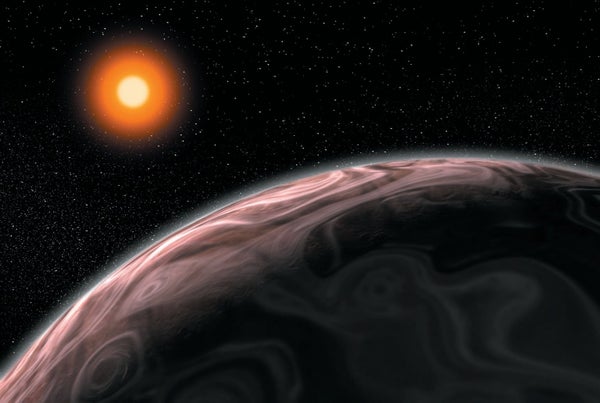When the Polish polymath Nicolaus Copernicus proposed in 1543 that the sun, rather than the Earth, was the center of our solar system, he did more than resurrect the “heliocentric” model that had been devised (and largely forgotten) some 18 centuries earlier by the Greek astronomer Aristarchus of Samos. Copernicus—or, rather, the “Copernican principle” that bears his name—tells us that we humans are nothing special. Or, at least, that the planet on which we live is not central to anything outside of us; instead, it’s just another ordinary world revolving around a star.
Our apparent mediocrity has only ascended in the centuries that have passed since Copernicus’s suggestion. In the middle of the 19th century Charles Darwin realized that rather than being the “crown of creation,” humans are simply a natural product of evolution by means of natural selection. Early in the 20th century, astronomer Harlow Shapley deepened our Copernican cosmic demotion, showing that not only the Earth but the whole solar system lacks centrality, residing in the Milky Way’s sleepy outer suburbs rather than the comparatively bustling galactic center. A few years later, astronomer Edwin Hubble showed that galaxies other than the Milky Way exist, and current estimates put the total number of galaxies in the observable universe at a staggering trillion or more.
Since 1995 we have discovered that even within our own Milky Way roughly one of every five sunlike or smaller stars harbors an Earth-size world orbiting in a “Goldilocks” region (neither too hot nor too cold) where liquid water may persist on a rocky planetary surface. This suggests there are at least a few hundred million planets in the Milky Way alone that may in principle be habitable. In roughly the same span of time, observations of the big bang’s afterglow—the cosmic microwave background—have shown that even the ordinary atomic matter that forms planets and people alike constitutes no more than 5 percent of the cosmic mass and energy budget. With each advance in our knowledge, our entire existence retreats from any possible pinnacle, seemingly reduced to flotsam adrift at the universe’s margins.
On supporting science journalism
If you're enjoying this article, consider supporting our award-winning journalism by subscribing. By purchasing a subscription you are helping to ensure the future of impactful stories about the discoveries and ideas shaping our world today.
Believe it or not, the Copernican principle doesn’t even end there. In recent years increasing numbers of physicists and cosmologists have begun to suspect—often against their most fervent hopes—that our entire universe may be but one member of a mind-numbingly huge ensemble of universes: a multiverse.
Interestingly though, if a multiverse truly exists, it also suggests that Copernican cosmic humility can only be taken so far. Many of the same researchers who assume the existence of a multiverse further speculate that random chance rather than any fundamental laws sets the values for some of the three dozen physical constants that dictate the characteristics of our reality. That is, things such as the density of the “dark energy” that drives the universe’s accelerating expansion, or the magnitudes of the “strong” and “weak” nuclear forces (which hold the atomic nucleus together and are responsible for some radioactive decays), can take drastically different values in different members of the multiverse. Moreover, even what we call “laws of nature” may be no more than local bylaws governing our particular patch of the multiverse. And, similar to how there are infinitely more wrong answers than correct ones for a simple math problem, the odds are such that, if the multiverse exists at all, most members of the ensemble of universes should be stillborn or sterile. The laws and constants prevailing in them may altogether preclude the emergence of complexity and life. Obviously, then, we will find ourselves not in a “typical” lifeless universe, but in a “special” member of the multiverse—one belonging to that subclass of universes that allow life to emerge and evolve. With this staggering possibility, the Copernican principle has seemingly reached its limits.

An engraving of Polish polymath Nicolaus Copernicus. Credit: North Wind Picture Archives/Alamy Stock Photo
Intriguingly, our current astronomical search for life beyond the solar system may tell us whether the Copernican principle breaks down at an even earlier stage than at the speculative and lofty level of the multiverse. Extrapolating from our current knowledge of how stars of all kinds are born, live and die—and how a subset of them host potentially habitable Earth-size planets in their habitable zones—one can estimate the relative likelihood for life’s emergence in the universe as a function of time. Not surprisingly, since low-mass stars are the most numerous and they last the longest (for example, stars with a mass 10 times smaller than that of the sun can shine for trillions of years), one finds that life in the cosmos is much more likely to exist in the very distant future on a planet orbiting a low-mass star, rather than on a planet such as Earth orbiting a star like our sun today. In other words, life on Earth appears to be very premature and rather, well, “special”—indicating a potential violation of the Copernican principle. Unless, there are other factors that either prevent life from emerging on planets around very low-mass stars, or if the probability for life’s emergence decreases fast enough over time. The factors potentially inhibiting prebiotic chemistry are legion. They include well-established facts—such as the tendency for red dwarf stars to emit strong flares and other stellar outbursts that could strip planets of their atmospheres—in addition to well-motivated speculations, such as asteroid impacts upon a young planet needing to be in a Goldilocks-like state of neither too numerous to disrupt biogenesis nor too sparse to starve prebiotic chemistry of molecular precursors thought necessary for life’s origins. Current and near-future astronomical searches for biosignatures in the atmospheres of exoplanets, which are concentrating on worlds around low-mass red dwarfs presently most amenable to study, could provide us with valuable clues as to whether life can exist in such unfamiliar settings, and thereby on whether we have reached the limits of the Copernican principle’s applicability. It is interesting to note in this respect that recent observations with the James Webb Space Telescope of the planet TRAPPIST-1b (which orbits a red dwarf star about 11 times less massive than the sun) suggest that this planet does not possess an atmosphere.
The implications of the Copernican principle may sound depressing to anyone who prefers a view of the world regarding humankind as the central or most important element of existence, but notice that every step along the way in extending the Copernican principle represented a major human discovery. That is, each decrease in the sense of our own physical significance was the result of a huge expansion in our knowledge. The Copernican principle teaches us humility, yes, but it also reminds us to keep our curiosity and passion for exploration alive and vibrant.
This is an opinion and analysis article, and the views expressed by the author or authors are not necessarily those of Scientific American.
A version of this article with the title “Cosmic Humility” was adapted for inclusion in the October 2023 issue of Scientific American.
